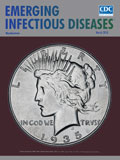
Volume 24, Number 3—March 2018
Letter
Ceftriaxone-Resistant Neisseria gonorrhoeae, Canada, 2017
On This Page
To the Editor: I read with great interest the report by Lefebvre et al. about a Neisseria gonorrhoeae isolate identified in Canada demonstrating a ceftriaxone MIC of 1 mg/L (1). The authors note: “As of October 15, 2017, only 5 ceftriaxone-resistant Neisseria gonorrhoeae isolates had been reported worldwide (MIC range 0.5–2 mg/L).” The authors cite published reports from Spain, Japan, Australia, and France.
I would like to clarify that additional N. gonorrhoeae isolates have been identified with ceftriaxone MICs >0.5 mg/L. Since 1987, as part of the Gonococcal Isolate Surveillance Project, the Centers for Disease Control and Prevention has been testing N. gonorrhoeae isolates for ceftriaxone susceptibility. During 1987–2016, the Centers for Disease Control and Prevention identified and reported 5 isolates with ceftriaxone MICs of 0.5 mg/L in the United States. These isolates were found in San Diego, California (1987); Cincinnati, Ohio (1992 and 1993); Philadelphia, Pennsylvania (1997); and most recently, Oklahoma City, Oklahoma (2012) (2). Therefore, although the number of N. gonorrhoeae isolates with ceftriaxone MICs >0.5 mg/L identified globally to date has been small, these Gonococcal Isolate Surveillance Project findings should be acknowledged. Continued and enhanced global surveillance of gonococcal isolates for antimicrobial susceptibility testing is imperative.
References
- Lefebvre B, Martin I, Demczuk W, Deshaies L, Michaud S, Labbe AC, et al. Ceftriaxone-resistant Neisseria gonorrhoeae, Canada, 2017. [cited 2017 Nov 19].Epub ahead of print.
- Centers for Disease Control and Prevention. Sexually transmitted diseases surveillance 2016 [cited 2017 Nov 19]. https://www.cdc.gov/std/stats16/CDC_2016_STDS_Report-for508WebSep21_2017_1644.pdf






















.png)











No hay comentarios:
Publicar un comentario